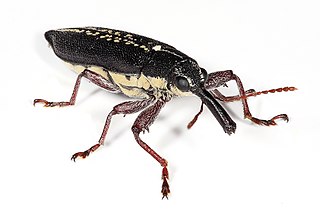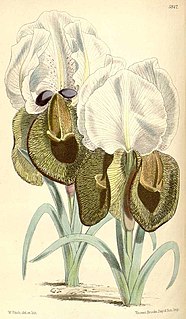Zyzzyva is a genus of tropical American weevils often found in association with palms. It is a snouted beetle. "Zyzzyva" is the last word in many English-language dictionaries.

Crambe is a genus of about 20 species of annual and perennial flowering plants in the cabbage family Brassicaceae, native to a variety of habitats in Europe, Turkey, southwest and central Asia and eastern Africa. They carry dense racemes of tiny white or yellow flowers on stems above the basal leaves.

Heterochromia is a difference in coloration, usually of the iris but also of hair or skin. Heterochromia is determined by the production, delivery, and concentration of melanin. It may be inherited, or caused by genetic mosaicism, chimerism, disease, or injury. It occurs in humans and certain breeds of dogs and cats.
Caridae is a small Gondwanan family of weevils. They are considered part of the primitive weevil group, because they have straight rather than elbowed antennae. The insertion of the antennae on the rostrum cannot be seen from above. Caridae also lack spiracles on abdominal tergites 6 and 7. The prothorax lacks lateral carinae. It has been suggested that the fossil weevil Eccoptarthrus belongs in this family, which would result in a change in the family name ; this proposal has been rejected by most coleopterists (e.g.)

Belidae is a family of weevils, called belids or primitive weevils because they have straight antennae, unlike the "true weevils" or Curculionidae which have elbowed antennae. They are sometimes known as "cycad weevils", but this properly refers to a few species from the genera Parallocorynus and Rhopalotria.
Rubeosis iridis, is a medical condition of the iris of the eye in which new abnormal blood vessels are found on the surface of the iris.

The Attelabidae is a widespread family of weevils. They are among the primitive weevils, because of their straight antennae, which are inserted near the base of the rostrum. The prothorax is much narrower than the base of the elytra on the abdomen. Attelabidae and the related family Rhynchitidae are known commonly as the leaf-rolling weevils. Rhynchitidae may be treated as subfamily Rhychitinae of the Attelabidae.

Iris spuria is a species of the genus Iris, part of a subgenus series known as Limniris and in the Series Spuriae. It is a rhizomatous perennial plant, from Europe, Asia and Africa. It has purple or lilac flowers, and slender, elongated leaves. It is widely cultivated as an ornamental plant in temperate regions and hybridized for use in the garden. It has several subspecies; Iris spuria subsp. carthaliniae B.Mathew, Iris spuria subsp. demetrii B.Mathew, Iris spuria subsp. maritima (Dykes) P.Fourn. and Iris spuria subsp. musulmanica (Fomin) Takht. It used to have 3 other subspecies, which have now been re-classified as separate species; Iris spuria subsp. halophila, Iris spuria ssp. sogdiana and Iris spuria subsp. notha . It has many common names including 'blue iris', 'spurious iris' and 'bastard iris'.
Lixus cardui is a species of true weevil found in Europe

Lixus concavus, commonly called the rhubarb curculio, is a species of weevil. Rhubarb is a host, together with dock, sunflower, and thistle.

Lixus angustatus is a species of weevil found in Europe and the Mediterranean Basin. The general size of the weevil is about 5.5 mm. The coloration of the weevil is brown and green.

Lixus is a genus of true weevils in the beetle family Curculionidae. There are at least 950 described species in Lixus.

Iris iberica is a species in the genus Iris, it is also in the subgenus of Iris and in the Oncocyclus section. It is a rhizomatous perennial, from the Caucasus mountains of Armenia, eastern Georgia, and western Azerbaijan. It has narrow, glaucous, gray-green and sickle shaped leaves, short stem holding a single flower in late spring. Which has a pale background covered with heavy veining in pale mauve, violet, dark purple, maroon or purple-brown. It has a black or dark purple signal patch and a brown or purple-brown beard. Although, it has many hybrid forms dues to its variability and has 2 known subspecies of Iris iberica subsp. elegantissima and Iris iberica subsp. lycotis. It is cultivated as an ornamental plant in temperate regions, as it is more hardier than other Oncocyclus species.

Lixus fasciculatus is a species of weevils belonging to the family Curculionidae.
Lixus parcus, the knotweed weevil, is a species of snout or bark beetle in the family Curculionidae. It is found in North America.
Lixus terminalis is a species of true weevil in the family of beetles known as Curculionidae. It is found in North America.
Lixus scrobicollis, the ragweed weevil, is a species of true weevil in the family of beetles known as Curculionidae. It is found in North America.

Lixus juncii is a species of weevil in the genus Lixus of the family Curculionidae.

Pseudaplemonus limonii is a species of weevil from the Apioninae subfamily. It lives on Common sea-lavender on the coasts of western Europe and northwest Africa.















